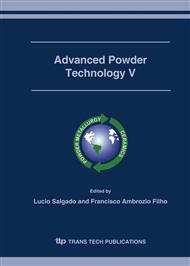p.401
p.408
p.414
p.421
p.425
p.432
p.438
p.444
p.449
Design of the Particle Size Composition of an Alumina Powder Matrix for Maximum Flowability and Minimum Water Content
Abstract:
In this work, commercial alumina fine powders were used as raw materials, namely two tabular alumina fractions (–500 mesh and –230 mesh) and a reactive alumina. Statistical modelling and the Response Surface Methodology (Statistica, Mixtures Designs and Triangular Surfaces module) were applied to three-component mixtures and used to calculate the various property-composition surfaces. To that aim, the various mixtures were prepared, cast, dried, fired and characterised. The particle size distribution modulus, q, was determined for all mixtures using the software LISA. The various response surfaces were then combined, so that the water content in the mixture could be minimised and the matrix flowability maximised. The properties of the resulting test-bricks (linear shrinkage, mechanical strength, apparent density and porosity) were also modelled and response surfaces were obtained. Combined results enabled the definition of an optimised particle size composition range, which guarantees the presence of a low water flow-bed that enables the aggregate self-flow.
Info:
Periodical:
Pages:
425-430
Citation:
Online since:
November 2006
Authors:
Price:
Сopyright:
© 2006 Trans Tech Publications Ltd. All Rights Reserved
Share:
Citation:


